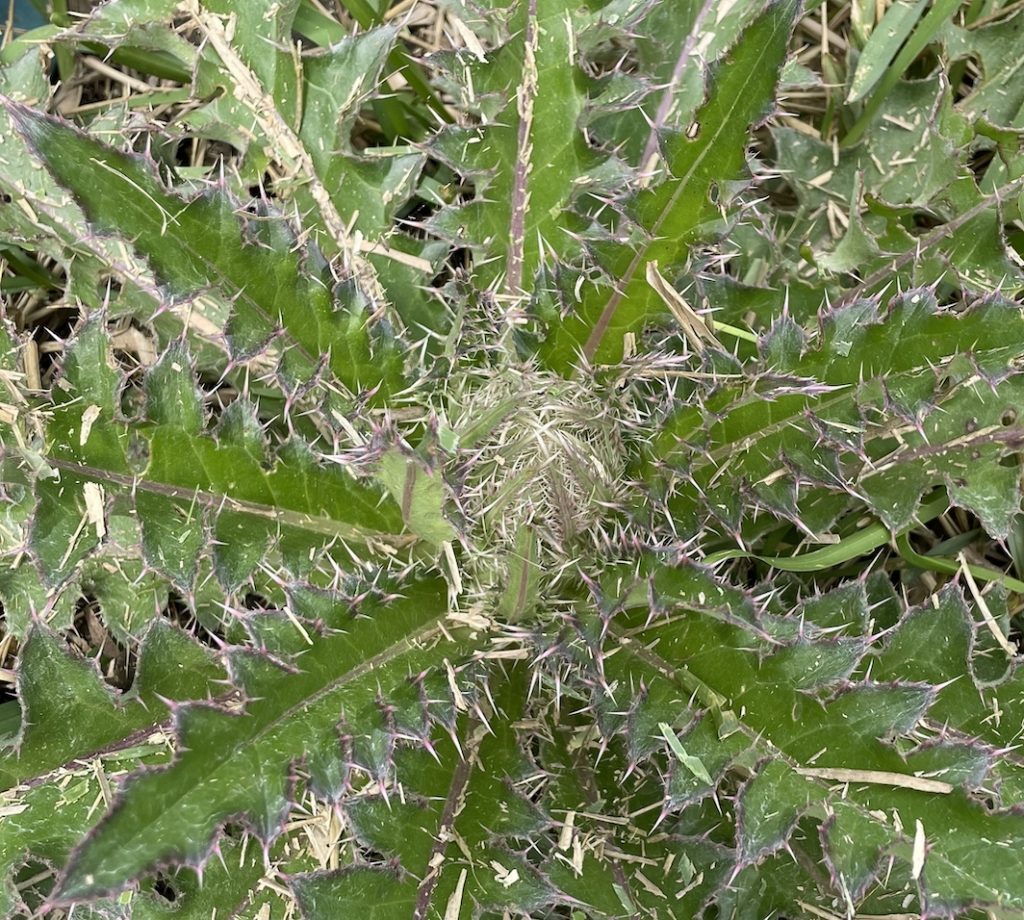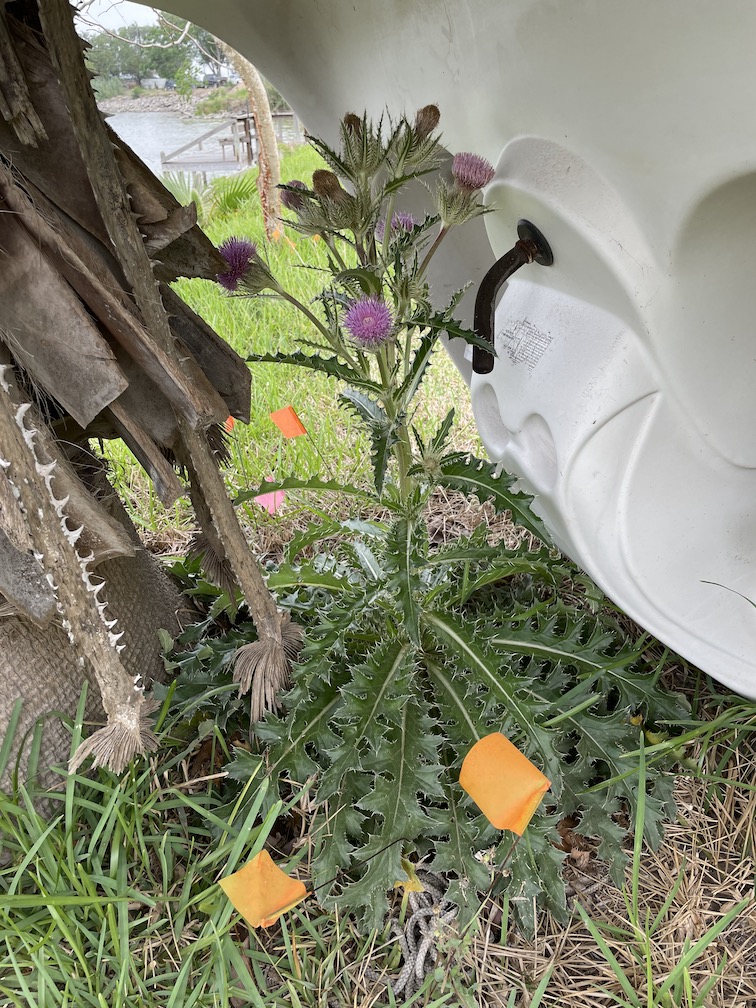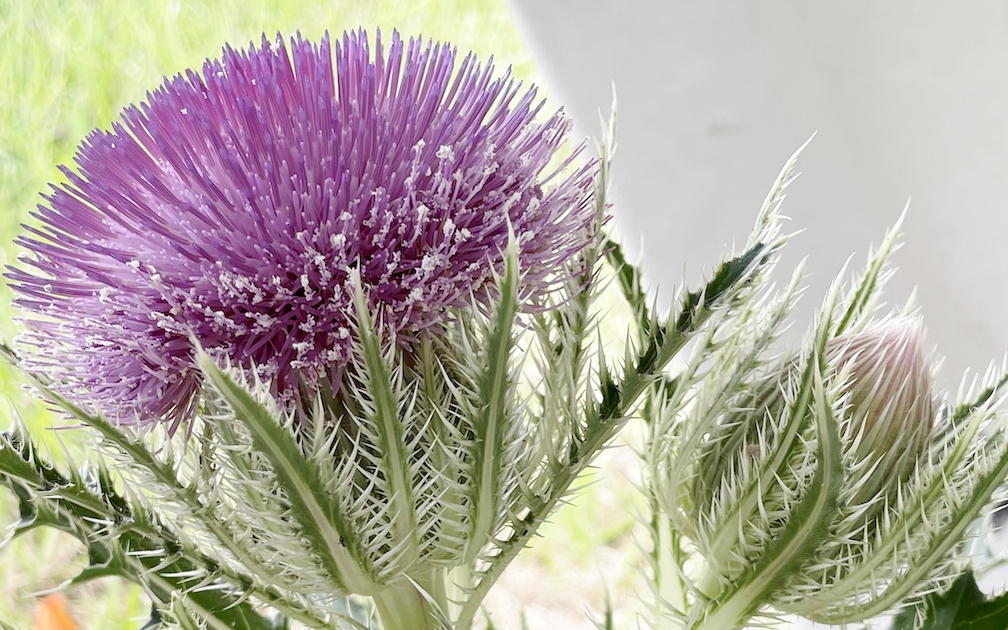Latin plant names, we’ve learned, often clue us in about the nature of a plant. See Eileen Mattei’s article, page 13, “Enough Latin Names to be a TMN,” at the December 2020 Chachalaca newsletter: https://rgvctmn.org/wp-content/uploads/2020/12/The-Chachalaca-Winter-2020.pdf
The Latin word horridulum isn’t as bad as it looks; it translates to: “somewhat rough; unadorned,” according to latin-is-simple.com. The word Cirsium derives from the Greek word kirsos meaning: swollen vein. Thistles were used as a remedy against swollen veins, according to Wikipedia.org. The translation for cirsium becomes more involved the more links that are followed — but that’s not what this story is about.

About 18 months ago, a rosette began appearing in the shade of the propped boat, right at the base of the palm. I began photographing this rosette and iNaturalist kept telling me it was thistle. Of course I knew that was wrong because the leaves of this new plant were sturdier, more gray than green and certainly more wicked-looking than any thistle I’d ever come across.
I have a pedal boat. It’s light enough for my husband and me to launch it onto the resaca waters and then haul up. We carpeted a section of retaining wall to use as a launching pad. After docking the boat, we prop it up and tie it to the trunk of a large Washingtonia palm tree that is next to the launching pad. That’s neither here nor there, either, but included to set the scene.
The rosette continued to expand but do little else as the months went by. And then suddenly, several weeks ago, a baby rosette appeared in front of the propped up boat.

Before I knew it, a huge bud pushed out of the center of each rosette, like a Phoenix rising, and voila! Both plants bloomed. And they were beautiful!
This time, iNaturalist told me it was thistle, and not just any thistle. Nor was it the Texas thistle, Cirsium texanum, of which I am so familiar. The spectacular new-to-the-yard plant is bristle thistle, Cirsium horridulum!
My policy is to not eradicate new plants until they bloom, and I can get them identified. If the plant turns out to be on the invasive list, I don’t keep it.
This thistle has a number of common names other than bristle thistle: bull thistle, purple thistle, spiny thistle, yellow thistle and horrid thistle. It’s really only horrid if one touches its leaves-like-serrated-daggers.

Bristle thistle is larval host to little metalmark and painted lady butterflies, a rich nectar source for bees and butterflies, and birds eat the seeds. Bristle Thistle (Cirsium horridulum) in bloom
Wildflower.og describes it as a tall branching stem with large yellow or red-purple flower heads and very spiny, clasping leaves. It grows one to five and a half feet tall, and the leaves are eight to 24 inches long. The yellow blooms are rare. Bristle thistle is often found along the edges of salt marshes; in the South, it also is considered a pasture weed.
Surprisingly, the blooms on the bristle thistle plants I’d been observing for so long rather quickly turned to seed, and the flower stalk withered and drooped. I will attempt to collect some of the seeds once they dry out from our rain storms that left the large seed heads in a sodden mass.
Wikipedia.org describes Cirsium horridulum as a North American species of plants in the thistle tribe within the sunflower family. It is an annual or biennial — both of which I believe I witnessed in our yard. It is native to the eastern and southern United States from New England to Florida, Texas and Oklahoma as well as to Mexico, Belize, Guatemala, Honduras and the Bahamas.
Bristle thistle has a large taproot and fleshy side roots that sometimes sprout new shoots, which explains the junior plant in front of the boat. There are usually several flower heads, also with sharp spines. Both my plants had several flowers on each plant. As long as it took to push out the flower heads, they didn’t last long. Not as long as the bloom period of Texas thistle.
I have not seen bristle thistle before, and certainly not anywhere around our neighborhood so it is a mystery how the first one simply appeared one day and continued to grow for so long in the shade of the pedal boat before attempting to flower, and then the smaller plant, which bloomed within a couple of months after appearing.
Interestingly, Wikipedia.org writes that Cirsium horridulum is endangered in Connecticut, New Hampshire and Pennsylvania and threatened in Rhode Island, while Arkansas and Iowa list the Cirsium genus as a noxious weed.
It will be interesting to see where the wind blows the seeds, since the plant is so close to the resaca. Will they be captured by the north wind during these recent sporadic cold fronts, or will the southerly trade winds send them elsewhere?

Leave a Reply